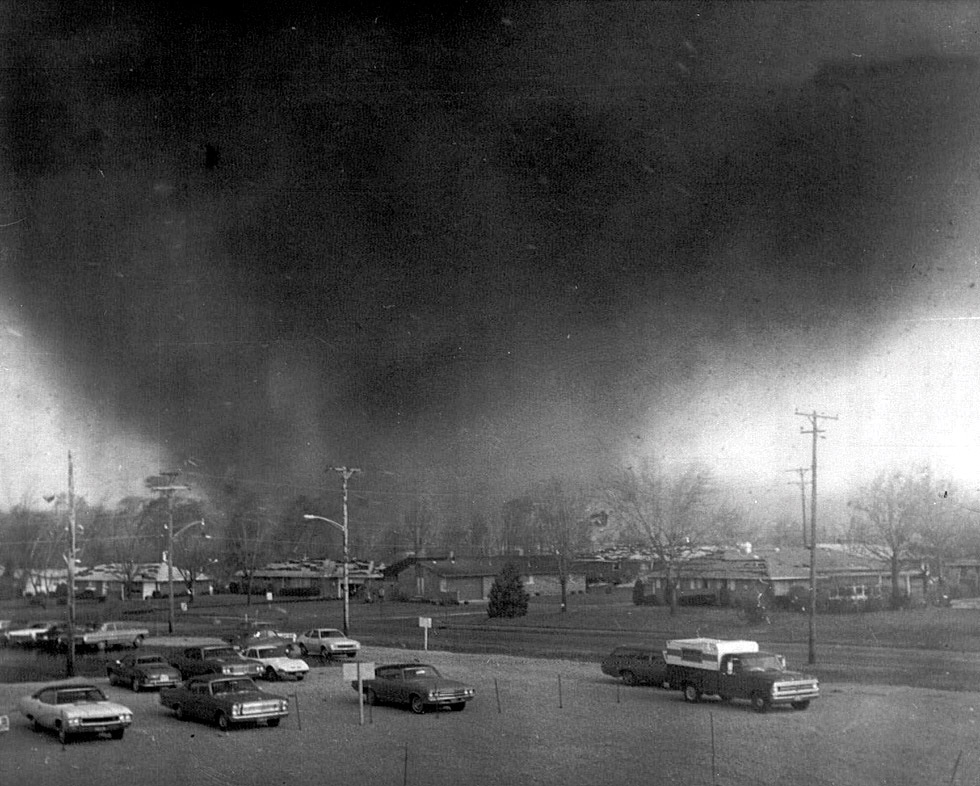In the spring of 1974, a ferocious weather system brutalized communities from Michigan to Mississippi, killing hundreds, injuring thousands, and laying down billions of dollars in damage. The U.S. Weather Service documented 148 tornados in 24 hours, labeling the phenomenon “The Super Outbreak.” Most people simply remember the catastrophe by the name of the southwestern Ohio town that saw the worst of it: the Xenia Tornado.

Photograph courtesy of United States Air Force, Wright-Patterson Air Force Base
The storm hit before the disaster warning systems we take for granted today. Xenia didn’t even have sirens to wail. Cathrine Wilson recalls that someone told her mother a bad storm was coming. “Mom said it was a spring shower,” recalls Wilson, then 9. Just minutes later, at 4:40 p.m. on April 3, 1974, she and her mother and sister hunched together in the bathtub against the roar of the wind and the shriek of exploding windows and ripped-away roofs. “It seemed to last forever,” she says.
The F5 category tornado brought winds up to 250 miles an hour, bulldozing a half-mile-wide swath through Xenia. But the cataclysmic storm system wasn’t done. At 5:30 p.m. another F5 touched down near Rising Sun, Indiana, passed into Northern Kentucky and knocked out power at the National Weather Service (NWS) station at CVG. When it crossed the river and blasted into Sayler Park, virtually all communication was shut down. There were no fatalities there, a blessing that may be attributed in part to the fact that the Xenia disaster had put residents on high alert.
The Super Outbreak set in motion a host of changes to weather reporting, including outdoor warning sirens, emergency power backup, and wider use of radar at NWS stations. (CVG had radar back then, but Dayton didn’t.) The experience prompted the NWS to adopt the F0–F5 Fujita scale as a standard for describing the severity of a tornado; it’s since been updated as the Enhanced Fujita Scale. Aerial photos of the Xenia debris fields and Cincinnatians’ snapshots of the Sayler Park funnel cloud helped scientists unravel what happened in the chaos. The storm demonstrated the critical need for research funding— research that ultimately led to the development of Doppler radar.

Photograph courtesy of National Weather Service
Thirty-three died in the Xenia storm, with countless injuries. An estimated 180 businesses and 1,200 houses—including the Arrowhead subdivision where Wilson lived—were flattened, along with 10 churches, two elementary schools, and the junior high. In that pre-FEMA era, help came from the Ohio National Guard, Red Cross, and regional aid workers. HUD arrived to organize housing, and President Nixon made an unannounced visit just days after the tragedy. By May, he’d signed amendments to the Disaster Relief Act of 1974 to include tornado recovery.
The adrenaline of crisis galvanized Xenia residents quickly. There were “Xenia Lives” bumper stickers and a Spirit of ’74 Committee assembled to map the way forward, as city leaders made plans for residential and commercial redevelopment. Some of the challenges they faced sound familiar to today’s pandemic experience: unemployment, closed schools, cancelled events, grief. But rebuilding was a tangible goal, and Xenia rebuilt. “We’re a tough group,” says Xenia Mayor Sarah Mays. She wasn’t even born when the 1974 tornado hit, but she was around for the 2000 storm that killed one person, and now she’s seen her neighbors respond to the COVID-19 pandemic. “I’m genuinely proud of my community,” she says. “We know we can pull together.”
Another lifelong resident, Marsha Bayless, was a first grade teacher in 1974. She served as Xenia mayor from 2010 to 2017 and agrees that her community is resilient, but she cautions that a disaster doesn’t wipe out divisions. “This forced people to come together,” she says, but “it doesn’t really last, and that’s unfortunate.” A 1982 case study of Xenia’s recovery by the Disaster Research Center at Ohio State University documents conflicts over residential planning, urban renewal, rezoning, and racial and socioeconomic inequities— conflicts every municipality must navigate, writ large post-disaster.
Xenia’s nightmare landscape has long been cleaned up, but Mays notes that there are still reminders of the struggle to revive the city. But neither she nor Bayless faults their predecessors. “They did the best they could,” says Bayless. And Mays, coping with the uncertainties of the current health crisis points out that hindsight will always be 20/20. “I’m sure that 30 or 40 years from now people will be saying, Why did they make that decision?”





Facebook Comments